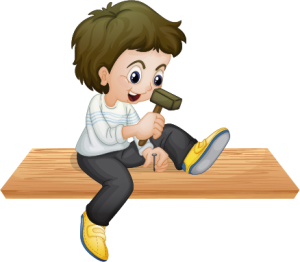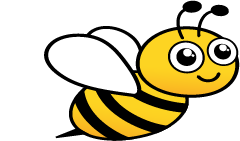
Level 1. Lesson 3. Beat & rhythm
![]()
![]() Woodblock
Woodblock
Difficulty: ![]()
Prior learning: Beat
Prepare: Rhythm Present: Practice: Beat
![]()
Students will develop proficiency and coordination by synchronising movements with the beat, enhancing group timing and collaboration.
![]() Lyrics
Lyrics
1. Johnny works with one hammer,
One hammer, one hammer,
Johnny works with one hammer,
Then he works with two.
(Hammer one fist lightly on leg)
2. . . . Two hammers
(Hammer both fists on legs)
3. . . . Three hammers
(Hammer both fists on legs and one foot on the floor)
4. . . . Four hammers
(Hammer both fists on legs and both feet on the floor)
5. ...Five hammers -
(Hammer both fists on legs, both feet on the floor, and nod head down and up)
Then he goes to sleep.
(Rest head on joined palms, pretending to go to sleep)
 Questions
Questions
- How many hammers did Johnny have?
- What happened after Johnny worked with five hammers?
- What other tools could he use?
- Have students form a circle to ensure everyone can see each other and stay engaged. Watching each other helps with synchronising movements and promotes a sense of group unity.
- The emphasis in this section is on maintaining a steady beat whilst performing body movements.
- Verse One: Sing the first verse and demonstrate gently tapping one fist on a leg in time with the beat. Practice together until students feel comfortable.
- Verse Two: Sing the second verse. Add the second fist, tapping the legs to the beat with both fists. Guide the students in maintaining a steady beat.
- Verse Three: Sing the third verse. Introduce one-foot stomping while both fists tap the legs, emphasising timing and coordination between the hands and feet.
- Verse Four: Sing the fourth verse. Stomp both feet alternately while tapping your legs with fists, practising coordination across all limbs.
- Verse Five: Sing the fifth verse. Continue with fist tapping and alternating stomps, and add gentle head nods in time with the beat.
- On the song's final line, have students bring their palms to their cheeks and rest their heads as though “sleeping.” This gives a calm finish to the activity and enhances expressive coordination.
- Sing through all five verses again, with the movements, guiding students to focus on the beat and timing. Repeat the entire song multiple times to solidify coordination, the beat, and collective timing.
- Encourage the class to sing and move together, reinforcing their ability to work as a cohesive group.
- Remind students to listen to each other and adjust their timing if needed.

 Success Criteria
Success Criteria
- I can perform each movement accurately in time with the beat.
- I can sing along while maintaining steady timing in my movements.
- I can stay coordinated with the group.
- I can complete the sequence of movements for all five verses and finish with the “sleeping” gesture.
- I can participate actively, contributing to the group’s overall timing.
![]() Students will learn to sing and coordinate body movements with their partners to enhance musical and social interaction.
Students will learn to sing and coordinate body movements with their partners to enhance musical and social interaction.
![]() Lyrics
Lyrics
Bow wow wow! Who's got a cow?
Little Tommy Tucker's dog. Bow wow wow!
- Arrange students in a circle, ensuring enough space between partners.
- Sing the song line by line, asking students to repeat after you until they are secure with the lyrics and melody.
- Demonstrate the Motions:
- "Bow wow wow" – stomp three times.
- "Who's got a cow?" – wag a finger at the partner three times.
- "Little Tommy Tucker’s dog" – hold both hands with the partner and perform a half-turn jump.
- "Bow wow wow" – perform another half-turn jump to face the partner again.
- Lead the class in singing and performing the motions. Model the actions and encourage everyone to participate while maintaining a steady beat.
- Students sing the song while performing the motions with their partners.
- After completing the song, students rotate to a new partner (optional).
- The game continues until all students return to their original partners.
 Success Criteria
Success Criteria
- I can sing the song confidently and match the beat with my partner.
- I can perform the movements accurately while keeping in time with the music.
 Questions
Questions
- Who has a cow?
- What could Tommy Tucker be doing with a cow?
- What noise was the dog making?

![]() Students will learn to sing confidently and match physical poses to the beat and melody of the song.
Students will learn to sing confidently and match physical poses to the beat and melody of the song.
![]() Lyrics
Lyrics
Everybody do this, do this, do this.
Everybody does this, just like me!
 Questions
Questions
- Which was the hardest pose?
- Which pose was the most fun?
- Can you think of a pose that nobody in class could do?
- Begin by introducing the song. If students are unfamiliar with it, teach the melody and lyrics line by line.
- Explain that today’s activity will combine singing with fun poses.
- Lead the class in singing the full song, guiding them through the melody and lyrics until they are confident.
- Ensure students stay seated and attentive during this stage.
- Use printed cards or projected images of the poses. Start with a straightforward pose and demonstrate it to the class.
- Encourage students to copy the pose while singing the song with you.
- At the end of the song, display or call out another pose for students to mimic while singing.
- Repeat this process, cycling through the poses to keep the activity dynamic and engaging.
- Encourage students to maintain a steady beat while singing and holding the poses.
- Pause to discuss which poses were their favourites and how it felt to sing while incorporating movements.
- Provide gentle feedback on both singing and the accuracy of the poses.
- Sing the song one final time, asking students to choose their favourite pose from the activity.
- Praise the class for their creativity, focus, and effort.
 Success Criteria
Success Criteria
- I can sing the song clearly and tunefully.
- I can copy poses while keeping time with the song.
- I can focus on both singing and movement simultaneously.
There are eight fun poses to download and print!
![]() Students will learn to connect visual beat icons with musical timing, improving their ability to follow and maintain a steady beat.
Students will learn to connect visual beat icons with musical timing, improving their ability to follow and maintain a steady beat.
![]() Lyrics
Lyrics
Bee, bee, Bumble bee,
Can you say your name to me?

 Questions
Questions
- Is a bumblebee the same as an ordinary bee?
- Can a bee really say your name?
- How many sounds are in your name?
- Teach students that the word that describes "the way the words go" is called rhythm. Write it on the board.
- Show the projected beat icons and explain that each icon represents one beat.
- Sing the song with the class, pointing to each beat icon in time with the music.
- When the song reaches "say your name," point at a student who will sing their name in response.
- Encourage students to focus on your pointing and connect it to the steady beat.
- Instruct students to keep the beat by patting their knees, shoulders, or heads while singing along.
- Practice the song together, ensuring students' movements align with the beat.
- Divide the class into two groups: Group 1 will clap the rhythm (the way the words go). Group 2 will patsch the beat (steady pulse).
- Practice the song while both groups perform their respective tasks.
- Switch roles so all students experience both beat and rhythm.
- Ask for a volunteer to come forward and point to the beat icons while the class sings.
- Rotate volunteers to ensure several students have the opportunity to lead.
- While students lead the pointing, have Group 1 and Group 2 continue their clapping and patsching tasks.
- Sing the song multiple times, varying the body movements (e.g., alternate between clapping, snapping, or tapping feet).
- Continue pointing to the beat icons and ensure groups are maintaining their roles.
- Recap the difference between beat and rhythm and their importance in music.
- Praise students for their participation and teamwork.
 Success Criteria
Success Criteria
- I know the difference between rhythm and beat.
- I can follow the beat icons while singing the song.
- I can keep the beat on my body in time with the music.
- I can take a turn pointing to the icons while the class sings.
![]() Students will learn to identify, clap, and move to the rhythm of the song.
Students will learn to identify, clap, and move to the rhythm of the song.
 Questions
Questions
- What is a bluebell?
- What is a cockle shell?
- Where could you find bluebells?
- Begin clapping the first four measures of the song to the class.
- Ask if anyone can name the song [audiation or inner hearing]. If not, clap again and hum the melody. Look for correct answers.
- Begin singing again and ask students to clap along to the words as they sing with you.
- Once students are comfortable clapping the rhythm, add variations using different body percussion movements every four beats.
- When secure, divide the class into small groups.
- Assign each group a line of the song to clap the rhythm.
- Have each group perform their line in order, creating the full song as a class.
- Challenge students to create their own rhythm patterns for the song using claps, pats, or snaps.
- Ask volunteers to perform their rhythm for the class while the rest of the students sing the song.
![]() Lyrics
Lyrics
Bluebells, Cockle shells, Eevy ivy over.
Bluebells, Cockle shells, Eevy ivy over.
 Success Criteria
Success Criteria
- I can clap the rhythm of the words in the song.
- I can match my movements to the rhythm of the song.
- I can create and perform a rhythm pattern for the song.
![]() Students will learn to identify and move confidently in left and right directions in a collaborative activity.
Students will learn to identify and move confidently in left and right directions in a collaborative activity.
 Success Criteria
Success Criteria
- I can step to the left and right when prompted.
- I can move in the correct direction while keeping in time with the group.
- I can follow verbal instructions to change directions.
- Have students stand in a circle, facing inward.
- Ask: “Are you facing to the right or to the left around the circle?”
- Demonstrate the directions by walking left and then right.
- Say: “If you’re not sure, turn and face the middle. Let’s work it out together!”
- Guide students to raise their hands if they think they are facing left.
- Confirm by walking left and asking: “Is this left? Let’s follow it around the circle.”
- Repeat the process for right.
- Practice by pointing and asking: “Who is facing left? Who is facing right?”
- Begin with simple directions: “Let’s all turn to the left and walk around the circle.”
“Now stop! Turn to the right and walk the other way.” - Add variety by introducing clapping or stomping while walking.
- Occasionally pause and ask: “Which way are you facing now? Left or right?”
![]() ASSESSMENT QUESTIONS
ASSESSMENT QUESTIONS
- The student can follow beat icons while singing a song.
- The student can identify a song by a clapped rhythm.
- The student can differentiate left from right in a circle.

Suggested lessons
Y1. Beat II

Y1. Beat III

Y1. Beat IV

